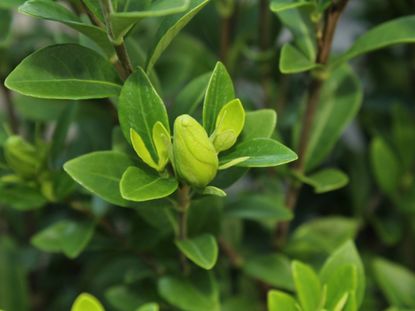Nellie Stevens Holly Care: Tips On Growing Nellie Stevens Holly Trees


Holly plants provide glossy, deeply cut leaves and brightly colored fruit year-round. Their ease of care makes them popular choices for gardeners in temperate to warm ranges. Growing Nellie Stevens holly trees provides you with one of the fastest growing of the hollies with branches packed with berries. The Nellie Stevens holly plant is a hybrid of Ilex cornuta and Ilex aquifolium. It has an interesting back story and an even more interesting growth form.
Nellie Stevens Holly Plant Info
Hollies are timeless classics that make a large impact on the landscape with very little special care required. These easy-to-grow plants provide cover and food for birds and natural holiday décor for the home. Nellie Stevens is a happy accident between a Chinese holly and an English holly. It was grown from berries filched by Nellie Stevens in the early 1900s. The resulting plant was almost removed in a home remodel in 1952 but was subsequently saved. Among this plant’s many attributes is its natural pyramidal form. It can grow up to 25 feet (8 m.) when mature and is one of the heaviest bearings of the hollies. Leaves are 2.5 inches (5 cm.) long with five to six deep teeth on each side and glossy green coloring. Much of the fruit seems to set without a male – Edward J. Stevens is the name for the male plant in the species – plant's intervention (parthenocarpic) and numerous pea-sized, red berries appear in fall. These plants are dense and make a nice screen and can be grown as either multi-stemmed or single stemmed plants. The plant was finally discovered by Nellie Steven's niece who took seeds to the Holly Society annual meeting for identification. The plant couldn't be identified, and a new species was named.
How to Grow Nellie Stevens Holly
This holly is very adaptable to either full sun or partial shade locations. It is resistant to deer and rabbits and will develop drought tolerance with maturity. The tree even thrives in poor soil and doesn't mind mild neglect, though plants prefer slightly acidic well-drained soil. Nellie Stevens is suitable for gardens in USDA zones 6 to 9. It is a fast-growing plant and useful as screen due to its thick foliage. Space plants 6 feet (2 m.) away when growing Nellie Stevens holly trees for a hedge effect. This holly is also remarkably resistant to most pests and diseases with the occasional exception of scale.
Nellie Stevens Holly Care
This has become a popular plant in cultivation since its introduction. This is partly because Nellie Stevens holly care is minimal, and the plant is resistant to a host of bothersome conditions and pests. Many gardeners may wonder, "Are Nelly Stevens berries poisonous?" Berries and leaves can be dangerous to small children and pets, so some caution should be used. Fortunately, the plant takes to shearing quite well and, although it forms a lovely shape naturally, pruning can help minimize berries at the lower heights. The best pruning time is early spring before new growth emerges. Most plants do not need regular fertilizing, but optimum health can be maintained with a granular slow-release food of a 10-10-10 ratio.
Gardening tips, videos, info and more delivered right to your inbox!
Sign up for the Gardening Know How newsletter today and receive a free download of our most popular eBook "How to Grow Delicious Tomatoes."

Bonnie Grant is a professional landscaper with a Certification in Urban Gardening. She has been gardening and writing for 15 years. A former professional chef, she has a passion for edible landscaping.
-
 Urban Composting Guide: How To Compost In The Middle Of The City
Urban Composting Guide: How To Compost In The Middle Of The CityUrban composting does not have to be daunting. You can compost in the city, and maybe even try some urban worm composting!
By Mary Ellen Ellis
-
 Shrub Diseases And Pests To Watch Out For
Shrub Diseases And Pests To Watch Out ForShrub diseases and pests can be challenging. Learn how to recognize and eradicate them before they can present a danger to your plants.
By Susan Albert